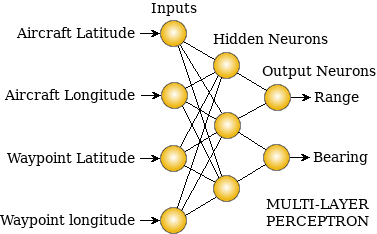![]() My Programs
My Programs
Family Finances
HTML word-counter
HTTP server
Web Browser
ROBOS
Neural Networks
Introduction
Multi-Layer Perceptron
Summation Function
Transfer Function
Complete Neuron
An MLP Program
Training The MPL
Applications
Predict trends in markets and other complex dynamic systems, predict localised short-term weather changes, assess crop conditions by spectral analysis of reflected light, predict long-haul short-term H.F. radio conditions, identify and extract intelligence from noisy signals, solve the travelling salesman problem in mobile networks, predict personal identification and compatibility for team building, maintain dynamic trim for boats & aircraft.
A neat little project that I would like to do as a sample application is to replace the Vincenty forward and reverse geodetic functions, in my global navigator program, with multi-layer perceptrons. The one for the 'Vincenty Solution to the Geodetic Inverse Problem' is shown below.

The above illustration shows only the simplest form of network. Notwithstanding, to obtain results with the precision and accuracy of my Vincenty functions as implemented, more hidden neurons could well be required.
During training, inputs would be sent to both the perceptron and the corresponding Vincenty function. The outputs from the Vincenty function would then be compared with those from the perceptron to obtain the output error for each output. These output error values would be then back-propagated to adjust the input weights to each neuron in the network.
If training were done on hundreds of flights all over the world, the perceptrons would gradually become able to navigate the globe with ever-diminishing error. The global navigator program switches to the best-fit reference geoid automatically according to where it is in the world. This way, the perceptron would eventually model the planet very accurately, warts and all; meaning that the best-fit geoids would no longer be necessary.
Although this exercise could be very useful for navigation, its value to me would be mainly as a practical means of substantiating, what is perhaps, my most profound personal conjecture about the universe. It is that — contrary to the thinking of Plato and also of one of my favourite modern mathematicians [who, incidentally attended my old school] — the Laws of Physics are not mathematical.
Mathematics is simply a language [a thing that exists only within the conscious mind] that provides us with a crude fit-kit of ideas through which we attempt to express how the Laws of Physics appear to work to us, from our points of view as we journey along our individual paths through time and space.
The real Laws of Physics that drive the objective universe are something else. They probably operate fractally at the finest scale within a continuously moving present with no past or future. And I think they will remain — fundamentally and eternally — beyond our ability to know them.
So if indeed it be possible to replace my Vincenty functions [which are wholly mathematical in nature with their sines, cosines, elliptical corrections and iterative convergence] with a multi-layer perceptron [which is a digital simulation of a strictly non-mathematical analogue process] then my conjecture is strongly substantiated.
I have alluded to this conjecture also elsewhere in the context of the optimum form for the path flown by an aircraft, as it passes its waypoints along an air route.